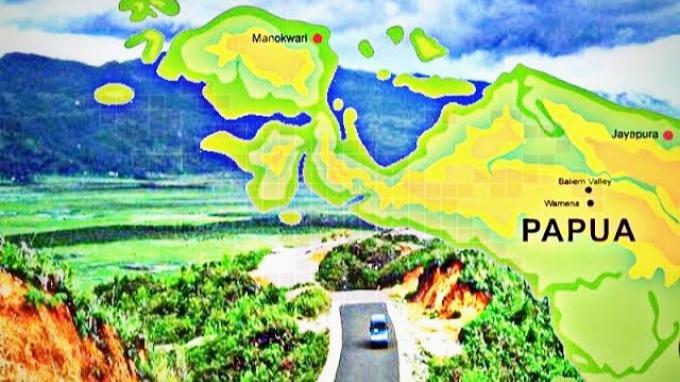Support the Government’s Efforts to Build Papua Border Roads
By : Alfred Jigibalom )*
Development in Papua is a manifestation of the government’s concern for eastern Indonesia. In order to strengthen the territorial border between Indonesia and Papua New Guinea, the government is building a 1,098.33 km border road in Papua.
The Ministry of Public Works and Public Housing (PUPR) continues to build border roads in several areas of Indonesia that are directly adjacent to neighboring countries. One of them is the construction of the Papua border road.
This development is one of the efforts to strengthen the territorial border between the Republic of Indonesia and Papua New Guinea. PUPR Minister Basuki Hadimuljono said the border road network is an infrastructure of strategic value for the Unitary State of the Republic of Indonesia.
Basuki said the function of the development was to serve as state defense and security and to support new economic growth centers in border areas. He added that the challenges in the construction of border roads in Papua are security disturbances, natural conditions that are still in the form of forests, mountains and weather.
Besides that, Basuki also explained, there were limited construction materials and access to the location was also difficult to reach, so logistics and labor were hard to come by. This work was also carried out in stages considering that the terrain was very difficult because they had to cross steep mountains, penetrate forests which were very difficult for construction workers and mobilization of work tools.
Director General of Highways Hedy Rahadian said the construction of the Papua border road was divided into three segments. Segment 1 Jayapura-Arso-Waris-Yeti with a length of 127.56 km. Segment 2 Yeti-Ubrub-Oksibil is 302.36 km long, and segment 3 Oksibil-Tanah Merah-Muting-Merauke is 668.41 km long.
As of April 2023, the physical progress of construction of segment 1 has reached 100%. While segment 2 is around 49.10% and segment 3 reaches 87.02%. Thus, the total border roads in Papua that have been built are 944.44 km long.
The implementation of the construction of the Papua border road in segments 1-3 from the 2015-2022 period with a budget of IDR 1.283 trillion and is targeted to be completed in stages with a target of road conditions by the end of 2024 consisting of 146.79 km of forest, 181.86 km of dirt roads, and 767.68 km of asphalt roads.
Hedy said, apart from strengthening the territorial borders between countries, the construction of the Papua border road also aims to open isolation and facilitate connectivity to the regional economic center. Thus facilitating the transportation of goods and people which will have an impact on reducing the prices of goods and services in Papua, thus reducing disparities between regions in Indonesia.
In 2023, border road construction will still be a priority for the government. The PUPR Ministry is targeting 3,707 km of border road construction throughout Indonesia, such as in Kalimantan, NTT and Papua to be completed by the end of 2024.
The construction conditions for the border road are 1,717.66 km of asphalt, 434.97 km of aggregate, 1,000.11 km of soil, and the possibility of leaving 198.84 km of forest.
Meanwhile, the government is also building the Sota Integrated Cross-border Post (PLBN) located in Merauke Regency, South Papua Province, which is the border area between the Republic of Indonesia (RI) and Papua New Guinea (PNG). The border area which was inaugurated by President Joko Widodo (Jokowi) on October 3, 2021, represents the face and progress of the Indonesian nation.
The Sota Integrated PLBN is the eighth PLBN to be built on the borders of Indonesia, and is the second PLBN in Papua after the Skouw PLBN in Jayapura. After the Sota PLBN, the government will then build another PLBN in Papua, namely the Yetetkun PLBN in Boven Digoel Regency, South Papua.
The construction of the Integrated PLBN is the Government’s commitment in encouraging the distribution of development results and reducing disparities. Particularly in the foremost, outermost and underdeveloped (3T) regions, in accordance with President Jokowi’s Nawacita mandate five years ago, namely to build Indonesia from the periphery.
PLBN Sota was built with an integrated concept between commercial buildings with public and social facilities such as markets and housing. PLBN Sota is expected to be able to provide better and more comfortable services to Indonesian people crossing Indonesia to Papua New Guinea, and vice versa. It is also hoped that its presence will encourage the growth of new economic centers in the land of Papua.
The construction of the Sota PLBN area was carried out by the Papua Regional Settlement Infrastructure Center (BPPW), Directorate General of Cipta Karya, Ministry of PUP. The area is divided into core, sub-core and supporting zones with an area of 5.6 hectares. In the core zone, the PLBN main building covering an area of 1,000m2 has been completed, the Tasbara Gate, the Garuda monument or statue, interior work, perimeter fences, CCTV, portals, flagpoles and signage, X Ray Scanners, and Walkthrough metal detectors.
PLBN itself is expected to be able to improve services in border areas as well as encourage the growth of new economic centers and make people on the border more love and proud of Indonesia.
The government’s efforts to build Papua’s borders certainly deserve support from the community, considering that these efforts not only strengthen Papua territorially but also make the people of Papua proud of the Unitary State of the Republic of Indonesia.
)* The author is a Papuan student living in Bali
